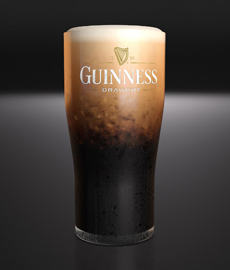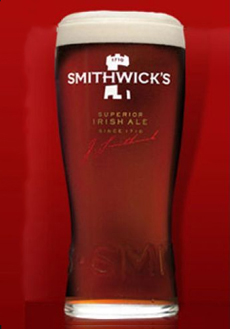TIP OF THE DAY: Authentic Irish Beer Styles
|
Forget the green beer on St. Patrick’s Day: It’s going to be the cheapest brew on tap. Who would color craft beer green? If you must do so, go for the palest style, Wheat Beer, a.k.a. Weissbier, Weizenbier and Witbier. It takes the color best. Instead of the green stuff, consider two beer styles with authentic Irish roots: Dry Stout and Red Ale. American craft brewers from coast to coast make them. In fact, Irish Red Ale is more popular in the U.S. these days than in Ireland! Dig in to the two styles below, and check out the other types of beers in our Beer Glossary. IRISH-STYLE DRY STOUT Stouts are a higher-alcohol version of porter (7% A.B.V.* or higher), a dark beer made from roasted malt or roasted barley, hops, water and yeast. All Stouts are Porters, but they are the stronger Porters (the “stoutest” ones). You can review their history and brewing techniques at BeerConnoisseur.com. There are different Stout styles, including American Sweet Stout; Baltic Porter; Milk Stout/Sweet Stout/English Sweet Stout, made with lactose, milk sugar; and Imperial Stout/Russian Imperial Stout, a style first brewed in the 18th century for export to the court of Catherine the Great. |

Guinness, the world’s most famous Stout. Annual sales are almost $2 billion. Photo courtesy Romano. |
|
|
But the most common style of Stout is Dry Stout, the Irish-style Stout represented by Guinness Draught, the world’s best selling Stout. In the early 20th century, when Milk Stout/Sweet Stout became the dominant style in England, Ireland maintained a preference for the non-sweet or Dry Stout, also known as Standard Stout. With the world dominance of Guinness, it is now simply referred to as Stout. Irish-style Dry Stouts are black in color with notes of coffee-like roasted barley and a roasted malt aroma. The hop bitterness is medium to medium high. The head is tan or tan-tinged. Dry stouts made by American craft brewers include: You may also find Guinness Black Lager, a lager style made with stout’s roasted barley, which provides the dark color and fuller body; and Harp Lager, a conventional style. |
||
 Imported from the Emerald Isle: Smithwicks Red Irish Ale, the first modern Irish Red Ale. |
IRISH RED ALE
Traditional0 Irish Red Ales seems to have originated in 1710 at the Smithwick Brewery in Kilkenny. Today, Red Ales are even more popular in the U.S. than in Ireland. The reddish or coppery hue is a result of brewing with a percentage of kilned malts and roasted barley. The style focuses on strong malt flavors with a light hoppiness and slight nuttiness/roastiness from the roasted grains. Irish Red Ales are usually well balanced, with an average A.B.V. of 3.5% to 5%, although you can find brews with up to 8% alcohol. You may find hints of caramel and toffee from the malt notes, along with a crisp, dry finish. |
|
|
AMERICAN CRAFT RED ALES TO LOOK FOR
|
||


